
The most haunting image of old Bunker Hill’s final days depicts a fenced off Victorian mansion awaiting its doom with “progress” looming in the background in the form of the Downtown’s first skyscraper, the Union Bank Building. The residence, affectionately known for years as “the Castle” and located at 325 S. Bunker Hill Avenue, was one of two residences on the Hill to escape the wrecking ball, only to meet an even more tragic end.
Located on Lot 16, Block L of the Mott Tract, early owners of the property were tee-totaling Los Angeles pioneer Virginia Davis and her husband John W., who sold the land for $450 to G.D. Witherell in March of 1882. It has long been believed that the Castle was built around this time, but an 1888 Sanborn Fire Insurance Map reveals the structure as being constructed. In 1887 the property changed hands again, so it probably was capitalist Reuben M. Baker who built the large Victorian structure that would be a mainstay on Bunker Hill for over 70 years.

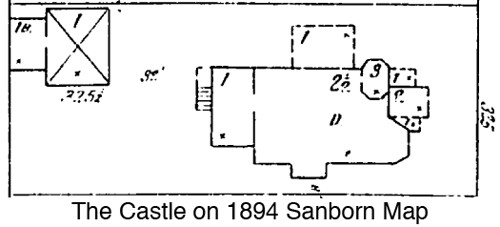
Designed in the Queen Anne style, the residence had 20 rooms, both a marble and a tile fireplace, and a three story staircase winding up the center of the house. Two of the mansion’s most recognizable features were the stained-glass front door and an overhang on the north side for carriages to pass through to the rear of the property. The curved Mansard roof on the tower and the triangular crown of a front balcony were removed after sustaining damage in the 1933 Long Beach earthquake. The original address of the home was actually 225 S. Bunker Hill Avenue until an ordinance, passed in December 1889, changed street numbering throughout the City, much to the irritation of many an Angeleno.
In March of 1894, grading contractor Daniel F. Donegan purchased the property for $10,500 and moved in with his wife Helen and four children. Though the family lived there for less than ten years, the name Donegan became the one most associated with the house and it has long been believed that the clan were the ones who nicknamed the mansion “the Castle.” A piece of neighborhood lore involved Donegan attempting to clear a nearby rat infested property by offering local children 25 cents for each cat brought to him, to be used as four footed exterminators. Residents were soon irked when their feline pets began to disappear. By 1902, the Donegans had moved, and new owner Colton Russell soon converted the mansion into a boarding house, a role the Castle would play for the next six decades.
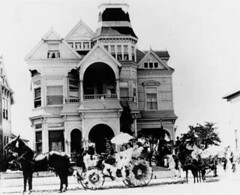
During its 60-plus year tenure as a multi-unit residence, the Castle would play host to all walks of life of the City of Angeles. Salesmen, doctors, waiters, elevator operators, miners, firemen, tailors, printers, hotel food checkers (well maybe just one of those), and many others called the Castle home at some point in their lives. When the WPA conducted a census of the area in 1939, 325 S. Bunker Hill Avenue was comprised of fifteen separate units, including a small guest house, built in 1927. The landlord’s family resided in four rooms while the rest of the tenants occupied single rooms and shared six toilets. The majority of the occupants were single, white and over 65 years of age. Rent ranged from $10 to $15 a month and occupancy at the Castle was anywhere from six months to eight years.
What the 1939 census failed to mention, however, was the Castle’s resident ghost.
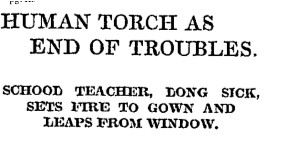
The spook who haunted the Castle could possibly have been a former resident who met their ultimate doom in the mansion. In 1914 Hazel Harding, a 28 year old former school teacher with a history of mental problems, lit herself on fire and jumped out a second story window. She survived the fall, but succumbed to her burns. In December 1928, 66 year Charles Merrifeld shot himself to death with a revolver in one of the rooms. Merrifeld, who committed suicide to escape the effects of poor health, had been the Castle’s landlord with his wife Bertha since 1919. The Widow Merrifeld would continue to oversee, what she advertised as, the Castle Rooms for an additional eight years following her husband’s death. According to residents interviewed for a 1965 Herald Examiner piece, for years the ghost contented himself with one type of action; “Everytime one of the sculptured wooden decorations falls off the wall, Mr. Spook catches it before it can shatter on the ground and deposits it neatly and safely on the front porch. So the crash doesn’t wake up the tenants.” Perhaps Mr. Merrifeld wasn’t quite ready to give up his duties as landlord.
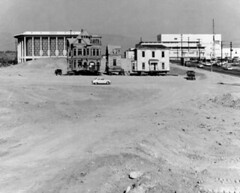
In 1955, the Community Redevelopment Agency (CRA) announced its plans to overhaul Bunker Hill, and by 1968 the only residences of the bygone era that remained were the Castle and the Salt Box, located at 339 S. Bunker Hill. Both structures were set to be demolished on October 1st of that year, but were saved in the eleventh hour when the Recreation and Parks Commission voted to let the homes reside on city owned land at Homer and Ave 43 in Highland Park. Additionally, the Department of Public Works agreed to move the structures to their new home which would become known as Heritage Square. For the Cultural Heritage Commission, the decision came after a six year battle to save the structures. Once moved, the CHC would then face the task of raising enough money to restore the age-worn buildings.

The Castle and Salt Box were relocated to their new home in March 1969 using $33,000 appropriated by the City Council and $10,000 from the CRA. Almost immediately the structures were invaded by vandals. On October 9, 1969 both houses were set on fire. Within minutes, the lone survivors of Bunker Hill’s Victorian era were gone forever.
All photos courtesy of the Los Angeles Public Library Photo Collection

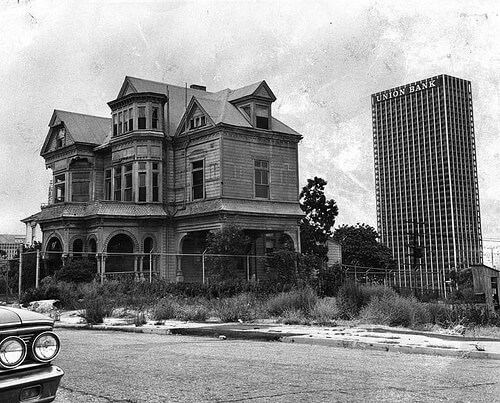
my name is jean karwelis, though im 47 years old i can remember going in the castle one time as a child. the experence has left its mark on me. when my father passed away 5 years ago i found a picture of he and i on the front porch. this was in 1968. when i found the picture memories came flooding back about that one day on the hill. i had to ask my mother "where was this taken" she said it was bunker hill. and that this house and one other had been saved. will i went on the hunt to find the castle, i needed to see it in person again. within short order i find where it had been moved, and i jump in my ruck and race to los anglels. to my suprise and horror, i find that im 30+ years late and it had burned down. the museum staff was really good to me. they took me to see the handful of artifacts that were left, and asked more questions than i could answer about the home. but this adventure has led me to learn everthng i could about bunker hill, and i have amassed a collection of photos 10,000+ of the buildings and life on the hill.
bunker hill is worth the effort
To the gentleman who left a comment about visiting the Castle as a child, please contact me as soon as possible.
I am a volunteer docent and researcher for Heritage Square Museum.
I am currently working on an exhibit about the history of Heritage Sqaure which of course was started in 1969 because of the Castle and Salt Box.
Could you please contact me at your earliest convenience by email:
victoriangentleman1867@yahoo.com
Thank you,
Victorian Gentleman 1867
Los Angeles, CA
Reader Jon Hartmann writes:
When the CRA started ripping up the history of Los Angeles, I
grabbed my camera and headed for the spots where they planned to wipe
out the most memories. I got to Bunker Hill when the last homes were
being carted off, I guess in 1968.Â
Much of my interest was in recording the remaining artifacts of
the Pacific Electric Railway. Even though most of the tracks and
right-of-ways had been destroyed, I managed to get there in time to
preserve many details that have since been obliterated. I have
pictures of the destruction of the subway tunnel, shots of the tracks
at Gardiner Junction, the facilities at Sherman as well as interior
shots of the Subway Terminal Building.  I became interested in how
General Motors and Standard Oil sabotaged rail service, and researched
186 F2d 562, 1949, wherein the defendants were found guilty of
"criminal conspiracy to monopolize ground transportation."
Here are four fascinating images he took in 1968. Bye-bye, Castle!
In the classic 1955 noir Kiss Me Deadly, The Castle stood in for the boarding house residence of Christina Bailey (Cloris Leachman), whose violent death early in the film launched detective Mike Hammer (Ralph Meeker) on a search through Los Angeles to find her killers. A night exterior scene shows the front of the house lit up and still in impressive shape; there were also interior scenes in the hallway, on the stairs, and in one of the upstairs rooms.
My family owned The Castle for 30 years until the CRA took it over in the late 1960’s. I remember the filming of Kiss Me Deadly. I remember thinking at the time that it was really something to have our property shown in a movie. They even used the correct address, 325 S. Bunker Hill Avenue. Little did I know that all these years later this would be all we have left besides our memories. The Castle was beautifully shown in its brief appearance, especially the stained glass front doors. Too bad it was in black and white because they were even more beautiful in color (see Leo Politi’s book for a hint of what they were like in color). The interior scenes of the entry hallway and the stairs were shot in The Castle. However, what was purported to be Chrisina’s appartment upstairs I don’t think was shot in The Castle. I don’t know where it was shot.
Gordon Pattison, aka Castle Dweller
In an article published in the Independent Press-Telegram (Long Beach), it states that the ‘Castle’ was built in 1882 by the Armour meatpacking family. The article published August 29, 1965 pg 209
have you got the bluprints?
They don’t exist, as far as we know.
Does anyone have pictures of North Flower Street? I’m searching for anything taken on the 200 North block to put in a family history. I know these were large frame buildings, but I’ve been unable to find them on the internet. I’m also searching for a map showing Flower Street up on the Hill. Every map I’ve found is so hard to use that it’s useless.
for the Castle dweller, i would love to talk to you about this home and recreating some drawing for floor plans so i can build a scale model of the castle. eventually i think i would donate all to the heritage square museum
my email is keoni121@aim.com
or call me 775-455-7986
Hello, I grew up in Los Angeles and my sister and brother’s used to play in Bunker Hill. Â I remember these houses like it was yesterday! Â We never vandalized them or anything like that!! Â We always showed respect for the Beautiful homes they were… and one day they were gone and we were so disappointed…And learning now, that they were Burnt up, just breaks my heart… I was born in 1949 and we were so poor, all we could afford was a two room tenement slum apartment for 7 of us. Â So I sure believed in the Magic Castle and that someday it would help me get out of the dump I was living in, and find my dream life with a beautiful home… Â I never found it… I found Jesus Christ and ever since I realized I am richer than any person!! Â Thank You for Sharing your pictures and for taking me back to my childhood !!